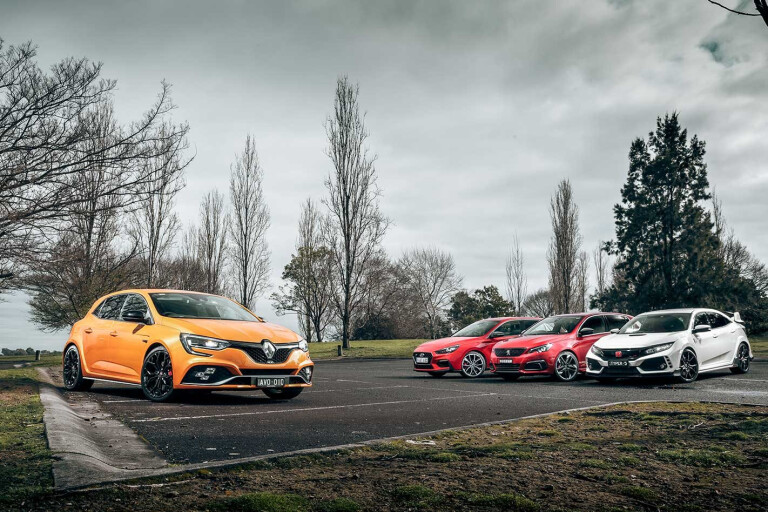
Life’s tough at the top – or so I’m told. Apparently it’s much more stressful being the hunted than the hunter, the pressure building with every new challenger that aspires to the throne.
Sustaining excellence is difficult, but the third-generation Mégane RS managed just that. The limited edition (and much more expensive) Ford Focus RS stopped it vaulting straight to the head of the class on its introduction, but from the initial Sport 250 to the final RS275 Trophy R it consistently ranked as our favourite front-driver.
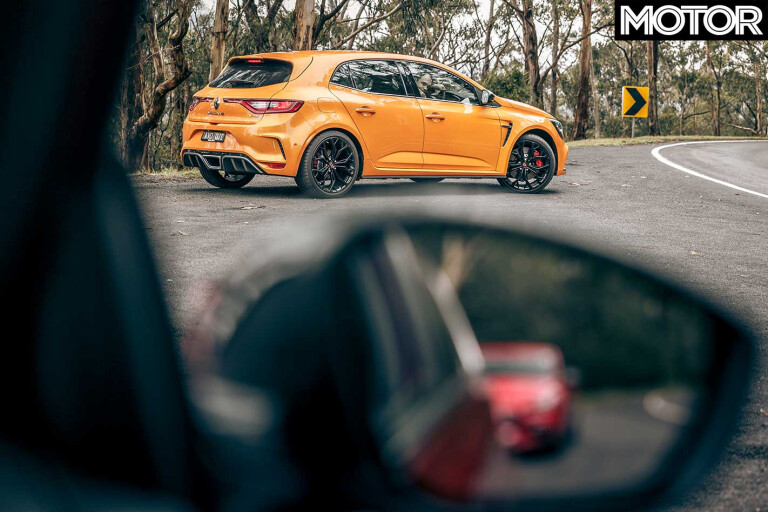
Now there’s a new top dog. The Honda Civic Type R has swept all before it, winning Performance Car of the Year and Bang For Your Bucks in the same year, an unprecedented achievement. It’s re-written the rulebook on what’s possible with driven front wheels, but has done so without the presence of a rival from Renault Sport. No longer, though this fight is a little premature.
Renault’s true Type R Competitor, the Mégane RS Trophy, is still almost 12 months away from Australian shores, but if the standard RS280 can give Honda’s hot hatch a run for its money, it bodes well for a return to Renault supremacy.
But this isn’t just a head-to-head. The Honda is present as the current benchmark, but at $51,990 it’s easily the most expensive car on test. And with 228kW/400Nm, it’s also the most powerful. Mere fractions separate the other three contestants, on the spec sheet at least.
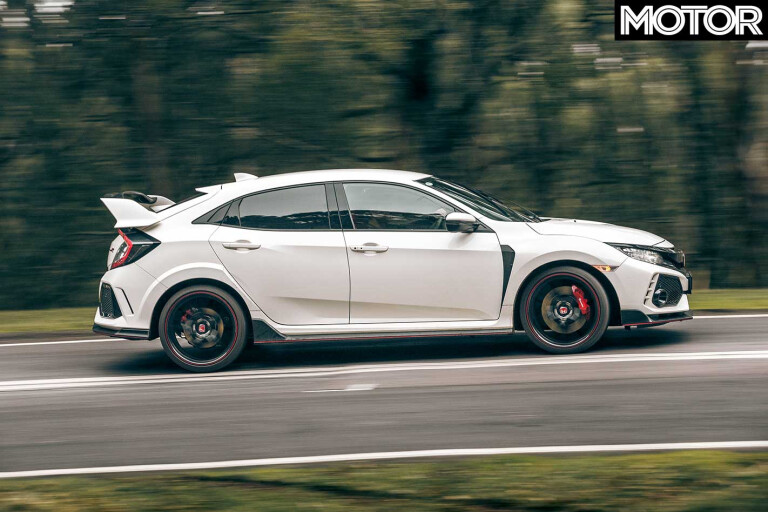
Like the Civic, they all use turbocharged four-cylinder engines, send power to the front wheels through a six-speed manual gearbox and limited-slip differential and have five doors. That in itself represents a major shift for the Mégane, as the Gen III RS was available only as a three-door quasi-coupe.
In an effort to broaden the appeal of its sporty best-seller, Renault has added a pair of doors and the option of a dual-clutch gearbox, the only car here to do so.
As you’d expect, we have a manual, fitted with the Cup chassis, which stiffens the suspension, adds a limited-slip diff and $1490 to the base Mégane’s $44,990 price. Despite losing 200cc, outputs swell to 205kW/390Nm from the 1.8-litre turbo four, shared with the upcoming Alpine A110 sports car.
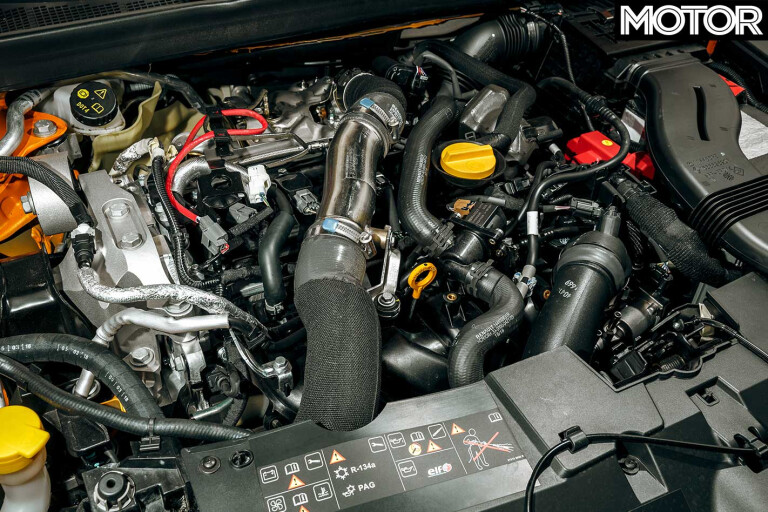
When it comes to doing more with less, however, its fellow Frenchie, the $45,990 Peugeot 308 GTi 270, leads the way by extracting 200kW/330Nm from just 1598cc. Last, but also least, from a dollars perspective, anyway, is the $39,990 Hyundai i30 N, a fresh young fish wading into shark-infested waters, albeit with a 202kW/353Nm (378Nm on overboost) bite of its own.
The key to a successful hot hatch is a dual personality, commuting comfort as important as potent performance. It’s why fast Golfs are so successful. Speaking of which, why no GTI? Simple, MY19 models have not yet arrived and there’s no longer a manual available. We’ll tackle that one in a future test.

Our hot-hatch quartet is split evenly on the appropriate solution to the ‘best of both worlds’ conundrum: Peugeot and Renault subscribe to simplicity, offering only the option to alter engine response, whereas Honda and Hyundai believe multiple modes are a better bet.
On the evidence presented here, the latter method is the pick. Being able to soften the dampers endows the Honda in particular with a brilliant ride, cushioning impacts and absorbing blows with a grace that many manufacturers could learn from. The Hyundai isn’t as comfy, but its Normal mode offers crucial compliance that rounds the edges off the nastiest bumps.
Both French cars react to the road more frequently, the Renault in particular constantly fidgeting on a poor surface. Whether it’s too firm will likely be down to personal opinion, but if you’re planning on daily driving your Mégane RS, be sure to test drive the Cup chassis before ticking the box.
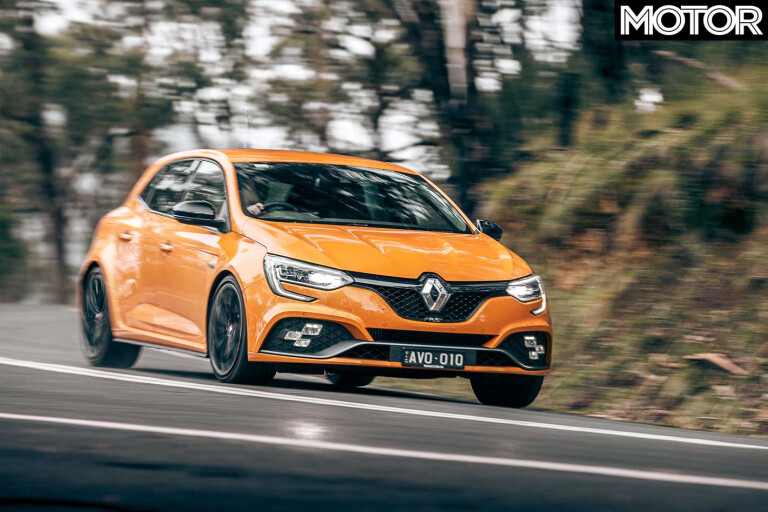
Of course, the Cup raison d’etre is handling precision. A Renault Sport product that doesn’t handle brilliantly is a pub with no beer, a gig with no music. Thankfully, the new RS delivers. As well as the introduction of the Torsen mechanical LSD, the Cup option brings 10 per cent stiffer dampers and bi-material brake rotors that shave 1.8kg per corner of unsprung weight and improve cooling.
In addition, hydraulic bump stops and all-wheel steering are standard, the rear wheels working in contrast to the fronts up to 60km/h and in concert above this speed to aid agility and stability respectively. In Race mode, the threshold increases to 100km/h.

It works – this Renault relishes being driven as hard as possible. Outright grip levels are enormous, but there’s ample adjustability if you’re willing to push hard enough to find it. With the ESC set to Sport the Mégane will happily dance around at the limit, oversteering a little on a lifted throttle and a lot with a trailed brake.
There’s genius in the damping, the way the chassis soaks up big compressions at speed with total control. The RS feels to almost glide across the surface, the light, accurate steering providing just enough feedback and rear-wheel steering aiding turn-in. All this with the supposed handicap of a torsion-beam rear-end.
Traction on dry roads is strong once the 245/35 Bridgestone Potenza S001s are up to temperature, but in the wet keeping the nose pointing straight can be a struggle in the first three gears. Sadly, the vaunted bi-material brakes feel awful. Their outright performance is fine – the Mégane’s 34.63m 100-0km/h stop is second-best on test – but pedal response is such it’s like marshmallow pads are fitted.
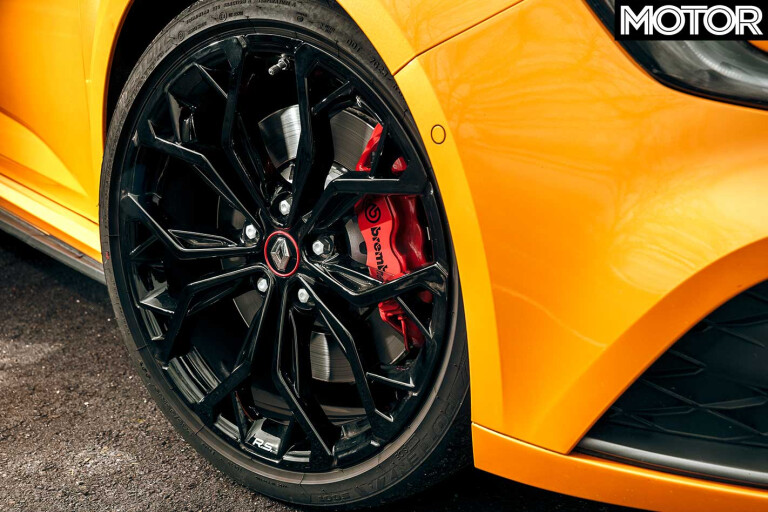
Jump on them hard and there’s a disconcerting hesitation as the system struggles to cope with the sudden change in pressure. Even in lighter use the soft pedal saps confidence and lengthens braking distances. It may just be this car, so some judgement will be reserved.
The Peugeot’s brakes offer greater response, though it’s not without its own issues. The slow steering – three turns lock-to-lock, though the turning circle is very good – is slightly compensated for by the tiny steering wheel, but the lack of feedback robs the driver of that crucial connection with the front tyres. Combine this with the too-high driving position and you constantly feel half a step behind what’s actually happening, preventing the ultimate exploitation of what is an excellent chassis.
Like the Mégane, the 308 GTi eschews the multi-link rear-end of the Honda and Hyundai, instead using a deformable torsion-beam setup to no real detriment other than a sideways shimmy when hitting mid-corner bumps under heavy load.
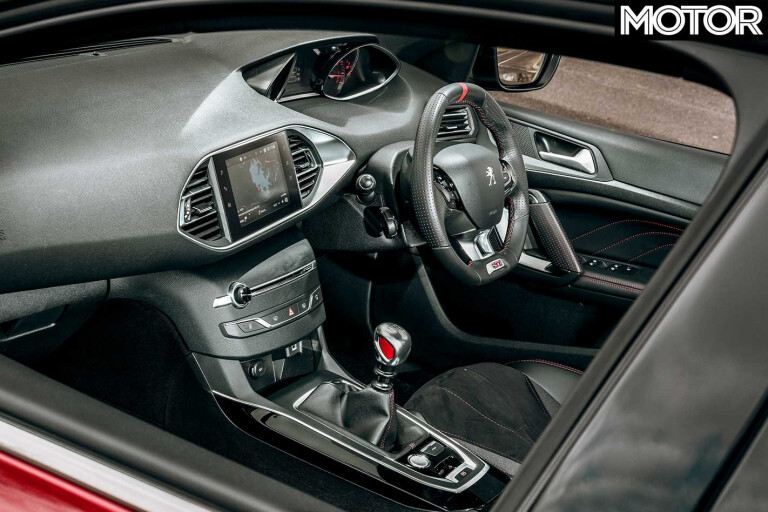
The steering could be quicker, but the passive suspension setup is a good compromise, understeer is strongly resisted and a well-timed dab of brake will step the rear out slightly in true French hot-hatch style. Steering aside, its biggest downfall is an unruly amount of torque steer in the wet.
The i30 N is much more composed. It’s easier to keep the Hyundai’s front end in line on slippery surfaces and in the dry traction is rarely an issue, the clever electronically controlled LSD continually shuffling power to where it’s needed most. In contrast, it’s the rear end that needs taming in the wet, the i30 N keen to wag its tail under brakes. In the dry this translates to a chassis that’s stable when you need it to be, but playful when you want it to be.
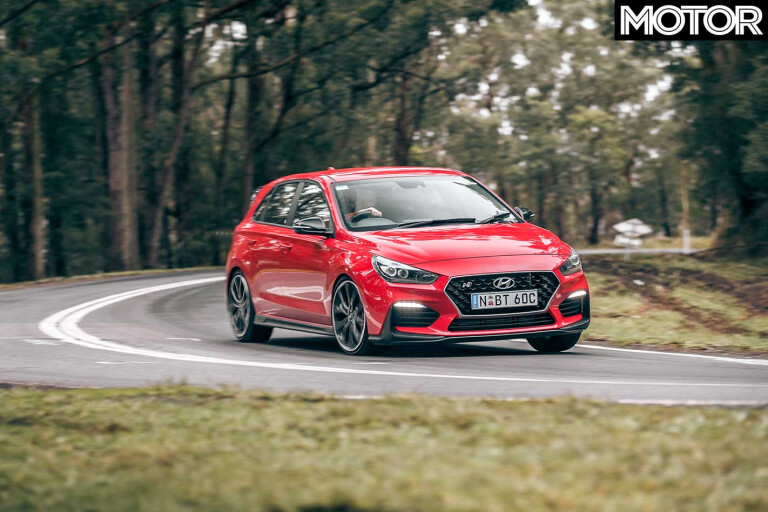
In contrast to the Peugeot, the steering offers plenty of feedback, while the Hyundai’s responsive brakes are superior to both French cars. In Normal mode the adaptive dampers breathe with the road nicely, a switch to Sport only necessary when severe mid-corner compressions test the bump stops, compressions which tax the Peugeot but are shrugged off by the Renault, it must be said.
Giving all three a lesson is the Honda. It’s not as playful as the Mégane – in fact, it’s the least likely of the quartet to move around – but that’s primarily because it’s going so much quicker than anything else. Its biggest drawback is the inability to alter the suspension, steering and engine modes individually – ideally you’d match Comfort steering to Sport damping and Sport Plus engine and ESP.
Nonetheless, the default Sport mode is enough to establish superiority. The Type R soaks up road irregularities with uncanny compliance, can be placed with millimetre accuracy, stops with unparalleled power and feel, hauls out of tight corners with virtually no wheelspin and offers grip – wet or dry – that only the Mégane has a hope of matching.
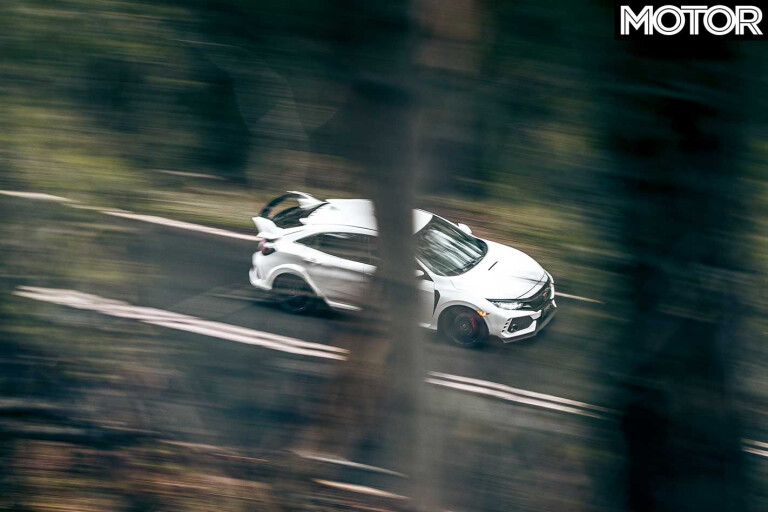
Sadly for its rivals, the dominance continues in a straight line. Times of 5.7sec 0-100km/h and 13.73sec at 173.98km/h are a fraction slower than our bests, but still enough to put relative daylight between it and the other contenders. Its buzzy engine note isn’t particularly appealing, but combine 228kW/400Nm with short gearing and a light, laser-accurate gearshift and you have roll-on acceleration that’ll give theoretically much quicker machinery a real headache.
The Peugeot comes closest. It may only have 1.6 litres to work with, but according to Peugeot the 308 has around a 200kg weight advantage, its 166kW/tonne power-to-weight ratio edging the Civic (164kW/tonne) and smashing the Mégane (145kW/tonne) and i30 (141kW/tonne). The numbers suggest its superiority isn’t so pronounced, but it definitely punches above its capacity, hitting 100km/h in 5.99sec and crossing the quarter in 14.04sec at 167.22km/h.

The Pug’s drivetrain is fantastic. There’s power everywhere, excellent response, a keenness to rev to almost 7000rpm and a pleasing, if obviously artificial, engine note in Sport. Not everyone is keen on the Peugeot’s long-throw gearshift, but I like the theatre it adds to each change and the action is refreshingly slick.
Mere fractions separate the French duo. Recording a 14.07sec quarter mile at 166.08km/h, the Renault trails the Pug by just 0.03sec and 1.14km/h. However, while its downsized turbo 1.8 is every bit as effective, it doesn’t feel as polished.
Power is plentiful and a 7000rpm cutout gives impressive reach, but everything from the throttle response to the engine note to the slightly apologetic pops on the over-run feels slightly contrived. It’s almost like distinguishing between the different modes was a higher priority than just providing the best possible connection with the driver.
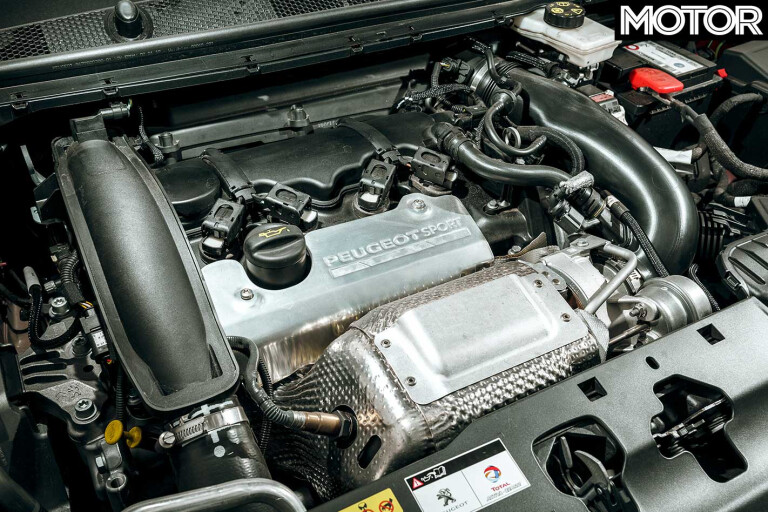
The Mégane’s quickest 0-100km/h effort of 5.94sec actually slightly bests the 308, but every other speed increment is slower than the run we’ve included in the data. Second gear runs to 102km/h, so nailing the best possible time requires wringing out every rev without hitting the limiter.
Performance testing quirks aside, the gearing complements the engine nicely and works very well on the road, while the shift itself is fine, shorter of throw than the Peugeot’s, but a little grittier.
Straight lines aren’t a happy hunting ground for the i30 N. It doesn’t help its own cause against the clock with non-killable traction control cutting power in first gear to control axle tramp. To be honest, its best times of 6.24sec 0-100km/h and 14.26sec 0-400m are a fluke, with times more commonly in the 6.5sec and 14.4sec regions respectively thanks to incessant electronic intervention.

Once rolling, it’s further handicapped against the clock by unusual gearing. Second gear is short, running out at 98km/h and necessitating another time-sapping shift to 100km/h, yet every other gear is relatively tall – trickery to optimise the 0-60mph (97km/h) time?
With no traction control issues and a slightly longer second gear, the i30 N would probably dip below 6.0sec 0-100km/h, for traction is strong and the gearbox, while notchy, allows for quick, accurate shifts.
The Hyundai is a fast enough car in its own right, but is the slowest car here and lacks the potency its outputs suggest. It's still in the game at 100km/h, but by 170km/h it’s 0.58sec behind the Renault, 0.76sec behind the Peugeot and whopping 2.21sec behind the Honda.
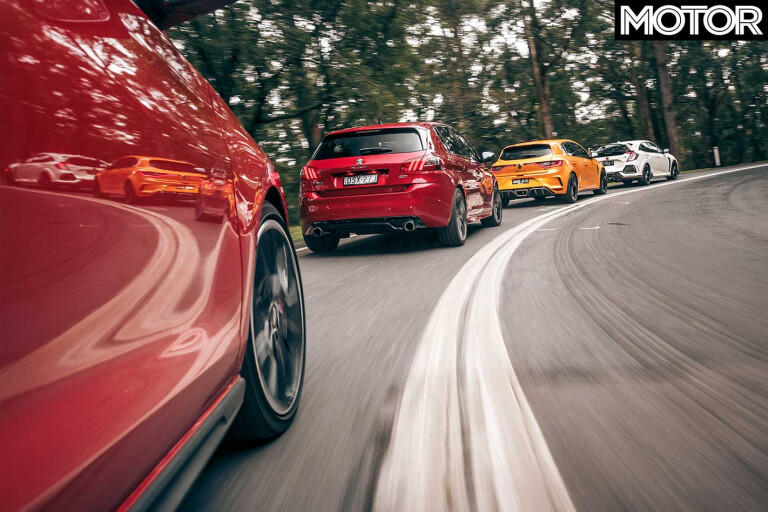
Mid-range torque is strong but power drops off dramatically beyond 6000rpm as the turbo runs out of puff – it feels a bit like they’ve installed the World Rally Car’s inlet restrictor. That said, it’s like they installed the anti-lag system, too, with each upshift accompanied by percussive cracks of unburnt fuel escaping the exhaust. Childish, yes, but addictive.
The i30’s trump card is its configurability, allowing drivers to save their favourite combination of settings – and there are a lot of choose from – to the ‘N Custom’ mode. For reference, my preference is engine, diff and exhaust set to their sportiest settings (with rev-matching most definitely off) but the steering in Normal, ESC in Sport and dampers in Normal with occasional forays into Sport.
As you’d expect from a hot hatch based on a best-seller, the i30 N nails the ergonomics. The driving position is a little high, but large, well-marked buttons and a responsive touchscreen make completing day-to-day tasks a breeze.
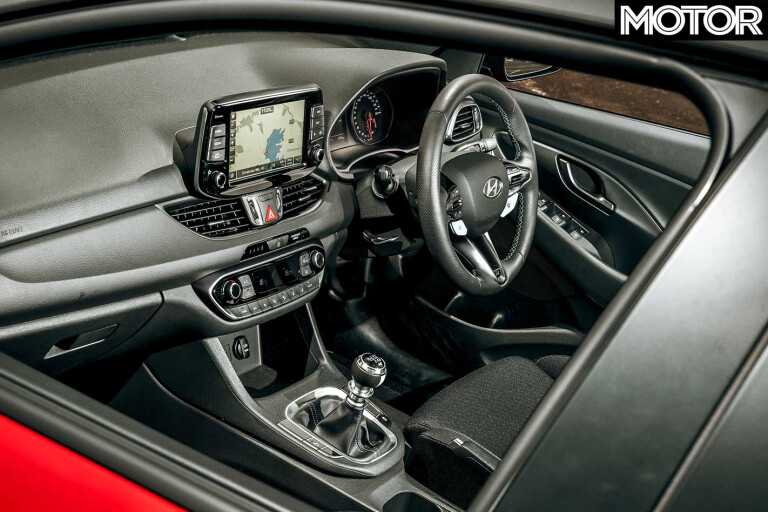
The Peugeot takes a different approach, moving virtually every control to the touchscreen to create a minimalist look. It’ll probably split opinion, but for me it works, the 308 GTi having the classiest interior on test. Unlike many, I can read the dials just fine with the steering wheel in its highest position, but you can keep the backwards tachometer.
Renault adopts a similar method, moving all controls bar HVAC to the portrait touchscreen. It looks cool, but doesn’t work as well as the Peugeot. The screen isn’t as responsive and is harder to navigate.
Helpfully, the R.S. Drive button in the centre of the dash allows the selection of a sportier drive mode with one touch. The Mégane looks great, however, the wider tracks giving it a proper bulldog stance, with menacing black 19s and neat touches like the giant rear diffuser and Aventador-like single exhaust outlet. It’s the looker of this quartet.

The Honda is not. We’re growing more accustomed to the Civic’s styling but it’s still far too busy. Its weakest link, though, is definitely its interior. The seats, wheel and gearshift are great, but the plastics are cheap and scratchy, the USB port a pain to access and the touchscreen infotainment plain irritating.
Despite this, it’s the clear winner of this test. Simply put, it’s the quickest with the most power and grip, has the best gearshift, the most comfortable ride, the most accurate steering and the most responsive and powerful brakes. It’s also the most expensive, so it should be the best, but the margin of victory is significant.

Hyundai secures second place on value, but that sells its impressive abilities short. It does exactly what a hot hatch should – it does everything. It doesn’t have the ultimate handling ability of the Renault or the engine character of the Peugeot, but is very close in both regards while being more comfortable and asking for less money. It’s a great car.
Splitting the French duo is very difficult: the order in which they finish will depend on your priorities. The Peugeot makes a strong case, for you will enjoy its drivetrain superiority far more often than the Renault’s on-limit handling advantage.
But the Renault’s peaks are higher and it comes alive on a difficult road just at the point the Peugeot begins to frustrate – if only the brakes were better. What is clear is that it’s no longer the benchmark.
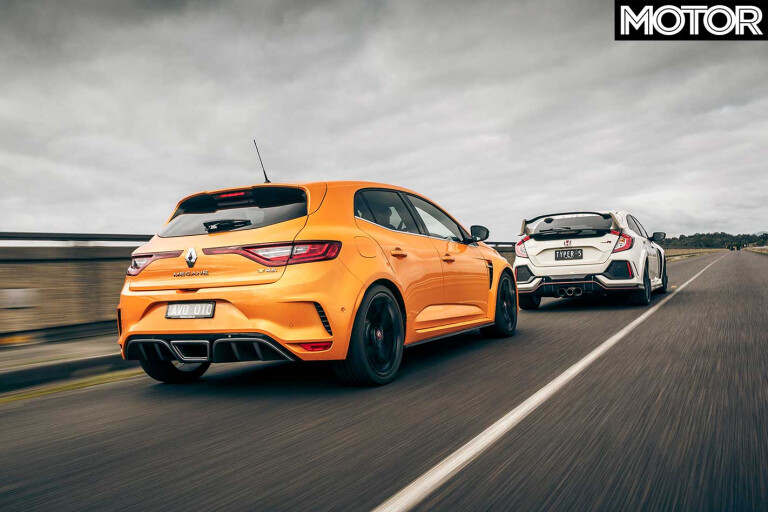
It’s good, even great in very specific circumstances, and Renault has broadened the Mégane’s appeal without sacrificing its core competencies more successfully than it did with the Clio RS. But the end result is similar: remarkable on-limit handling that comes at the expense of ride quality and an engine that’s effective rather than inspirational. Perhaps the more compliant Sport chassis is the pick for road use, but it's a shame the softer setup deletes the limited-slip diff.
This is the very beginning of the fourth-gen Mégane RS story and there’s certainly the potential to be great. Nonetheless, the Trophy is going to have to be a solid improvement if it’s to become the hunted, not the hunter.
Fast Facts

| Peugeot 308 GTi 270 | Renault Mégane RS 280 Cup | Honda Civic Type R | Hyundai i30 N | |
| Body | 5-door, 5-seat hatch | 5-door, 5-seat hatch | 5-door, 4-seat hatch | 5-door, 5-seat hatch |
| Drive | front-wheel | |||
| Engine | 1598cc inline-4, DOHC, 16v, turbo | 1798cc inline-4, DOHC, 16v, turbo | 1996cc inline-4, DOHC, 16v, turbo | 1998cc inline-4, DOHC, 16v, turbo |
| Bore x Stroke | 77.0 x 85.8mm | 79.7 x 90.1mm | 86.0 x 85.9mm | 86.0 x 86.0mm |
| Compression | 9.2:1 | 9.9:1 | 9.8:1 | 9.5:1 |
| Power | 200kW @ 6000rpm | 205kW @ 6000rpm | 228kW @ 6500rpm | 202kW @ 6000rpm |
| Torque | 330Nm @ 1900-5500rpm | 390Nm @ 2400-4800rpm | 400Nm @ 2500-4500rpm | 353Nm @ 1450-4700rpm (378Nm overboost) |
| Power / Weight | 166kW / tonne | 145kW / tonne | 164kW / tonne | 141kW / tonne |
| Transmission | 6-speed manual | |||
| Weight | 1205kg | 1407kg | 1393kg | 1429kg |
| Suspension | struts, coil springs, anti-roll bar (f); torsion beam, coil springs, anti-roll bar (r) | struts, coil springs, adaptive dampers, anti-roll bar (f); multi-links, coil springs, adaptive dampers, anti-roll bar (r) | ||
| L/W/h | 4253 / 1804 / 1447mm | 4364 / 1875 / 1428mm | 4557 / 1877 / 1421mm | 4335 / 1795 / 1447mm |
| Wheelbase | 2620mm | 2669mm | 2700mm | 2650mm |
| Tracks | 1520mm (f); 1540mm (r) | 1615mm (f); 1596mm (r) | 1599mm (f); 1593mm (r) | 1556mm (f); 1564mm (r) |
| Steering | electrically assisted rack-and-pinion | |||
| Brakes (f) | 380mm ventilated discs, 4-piston calipers | 355mm ventilated discs, 4-piston calipers | 350mm ventilated/drilled discs, 4-piston calipers | 345mm ventilated discs, 4-piston calipers |
| Brakes (r) | 268mm solid discs, single-piston calipers | 290mm solid discs, single-piston calipers | 305mm solid discs, single-piston calipers | 314mm ventilated discs, single-piston calipers |
| Wheels | 19.0 x 9.0-inch (f/r) | 20.0 x 8.5-inch (f/r) | 19.0 x 8.0-inch (f/r) | |
| Tyres | 235/35 R19 (f/r); Michelin Pilot Super Sport | 245/35 R19 (f/r); Bridgestone S001 | 245/30 R20 (f/r); Continental SportContact6 | 235/35 R19 (f/r); Pirelli P Zero |
| Price | $45,990 | $44,990 ($46,480 as-tested) | $51,990 | $39,990 |
| Pros | Great drivetrain; slick interior | Magic handling; looks great; very quick | Pace; ride; handling; brakes; gearshift | All round excellence; fun chassis |
| Cons | Driving position; slow steering | Stiff ride; soft brakes; engine just OK | Fussy looks; hit-and-miss interior | Engine lacks top end; gearshift |
| Rating | 3.5 out of 5 stars | 3.5 ouf ot 5 stars | 4.5 out of 5 stars | 4 out of 5 stars |
The Strip

| Hyundai i30 N | Honda Civic Type R | Renault Mégane RS 280 Cup | Peugeot 308 GTi 270 | |
| 0-10km/h | 0.51sec | 0.51sec | 0.52sec | 0.49sec |
| 0-20km/h | 1.09sec | 1.00sec | 1.01sec | 0.99sec |
| 0-30km/h | 1.58sec | 1.49sec | 1.47sec | 1.47sec |
| 0-40km/h | 2.04sec | 1.97sec | 1.95sec | 1.95sec |
| 0-50km/h | 2.52sec | 2.74sec | 2.43sec | 2.52sec |
| 0-60km/h | 3.27sec | 3.21sec | 3.18sec | 3.26sec |
| 0-70km/h | 3.81sec | 3.68sec | 3.72sec | 3.76sec |
| 0-80km/h | 4.42sec | 4.18sec | 4.33sec | 4.38sec |
| 0-90km/h | 5.10sec | 4.74sec | 5.00sec | 5.03sec |
| 0-100km/h | 6.24sec | 5.70sec | 6.04sec | 5.99sec |
| 0-110km/h | 7.16sec | 6.44sec | 6.89sec | 6.82sec |
| 0-120km/h | 8.14sec | 7.23sec | 7.80sec | 7.71sec |
| 0-130km/h | 9.19sec | 8.34sec | 8.80sec | 8.97sec |
| 0-140km/h | 10.37sec | 9.47sec | 10.26sec | 10.17sec |
| 0-150km/h | 12.15sec | 10.56sec | 11.69sec | 11.43sec |
| 0-160km/h | 13.64sec | 11.76sec | 13.12sec | 12.85sec |
| 0-170km/h | 15.33sec | 13.12sec | 14.75sec | 14.57sec |
| 0-400m | 14.26sec @ 163.87km/h | 13.73sec @ 173.98km/h | 14.07sec @ 166.08km/h | 14.04sec @ 167.22km/h |
| 80-120km/h (3rd - 6th) | 3.8 / 4.6 / 5.8 / 7.0sec | 2.9 / 3.5 / 4.7 / 6.5sec | 3.5 / 4.4 / 5.7 / 7.6sec | 3.3 / 4.3 / 5.5 / 6.8sec |
| 100-0km/h | 35.26m | 33.65m | 34.63m | 35.99m |
| Speed in Gears | ||||
| 1st | 62km/h @ 6750rpm | 58km/h @ 7000rpm | 64km/h @ 7000rpm | 56km/h @ 6800rpm |
| 2nd | 98km/h @ 6750rpm | 99km/h @ 7000rpm | 102km/h @ 7000rpm | 104km/h @ 6800rpm |
| 3rd | 149km/h @ 6750rpm | 137km/h @ 7000rpm | 142km/h @ 7000rpm | 138km/h @ 6800rpm |
| 4th | 199km/h @ 6750rpm | 187km/h @ 7000rpm | 192km/h @ 7000rpm | 180km/h @ 6800rpm |
| 5th | 247km/h @ 6750rpm | 231km/h @ 7000rpm* | 242km/h @ 7000rpm | 226km/h @ 6800rpm |
| 6th | 250km/h @ 5700rpm* | 272km/h @ 6650rpm* | 255km/h @ 6100rpm* | 255km/h @ 6500rpm* |
Heathcote Raceway, 12˚C, dry. Driver: Scott Newman
*Manufacturer’s claim

COMMENTS